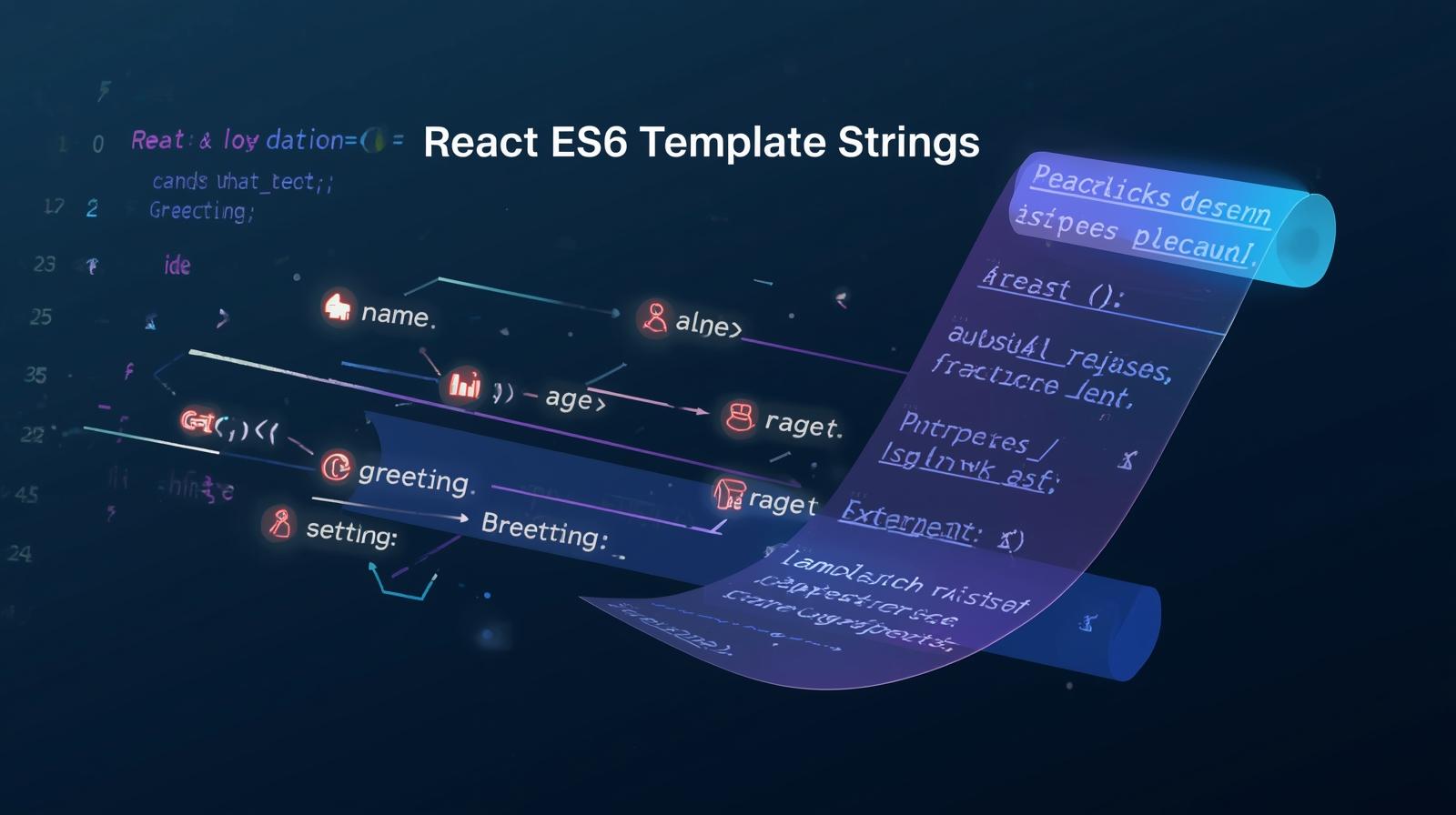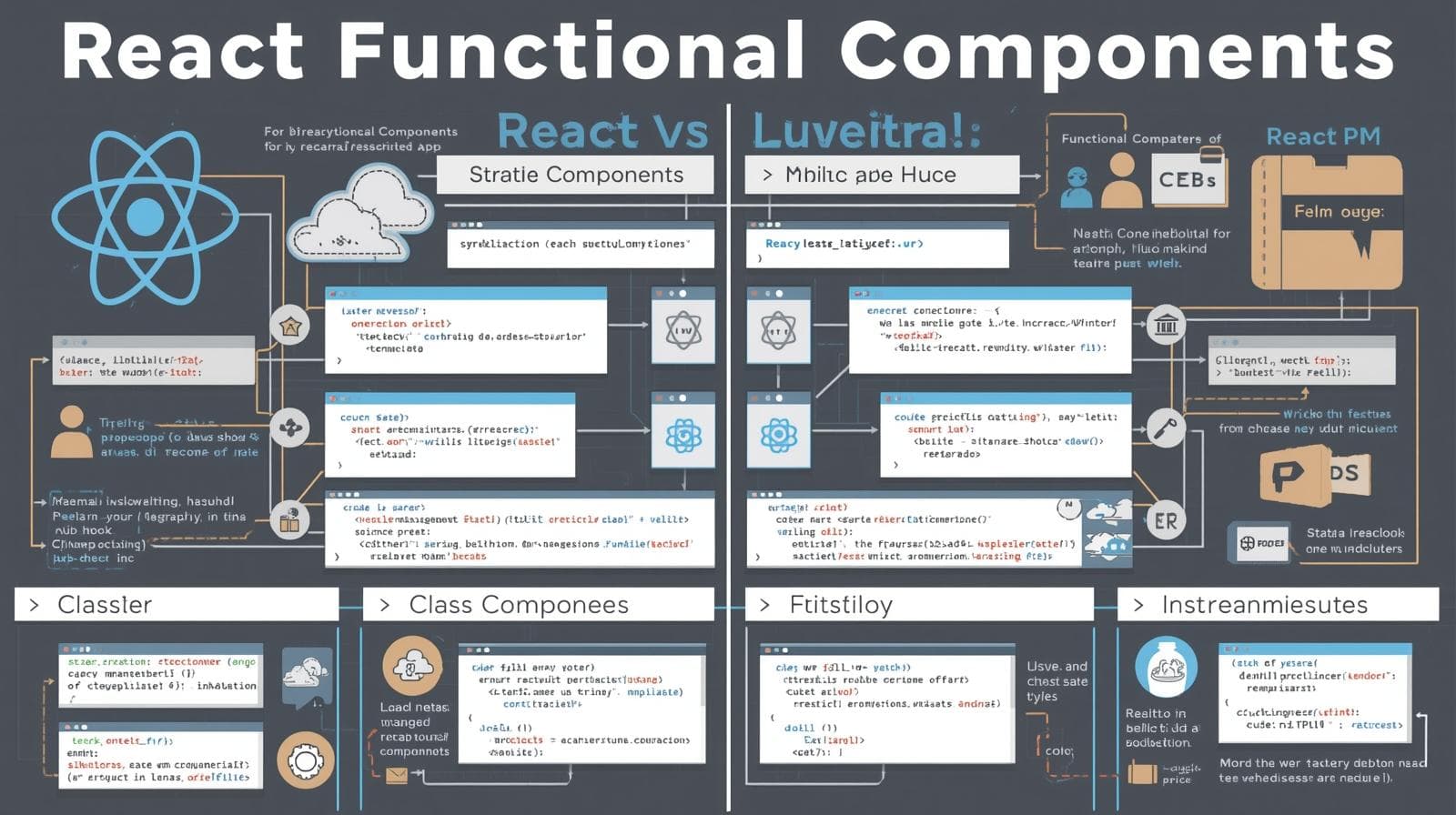Master React ES6 Template Strings: A Complete Guide with Examples & Best Practices

Unlock the power of ES6 Template Strings in React. Learn dynamic classNames, JSX interpolation, styled-components, and best practices to write cleaner code.

Master React ES6 Template Strings: A Complete Guide with Examples & Best Practices
Mastering React ES6 Template Strings: Write Cleaner, More Dynamic Code
Remember the days of juggling strings with the + operator, trying to piece together a dynamic CSS class or a user greeting? It was clunky, error-prone, and made our code look like a mess of quotes and plus signs. If you've been working with JavaScript or React for any time, you've probably breathed a sigh of relief upon discovering ES6 Template Strings (often called Template Literals).
But are you using them to their full potential in your React projects? These aren't just a slightly nicer way to write strings; they are a fundamental tool that can dramatically improve the readability, maintainability, and dynamism of your components.
In this comprehensive guide, we're going to move beyond the basics. We'll dive deep into how template strings can transform your React development, covering everything from dynamic styling to complex JSX interpolation, complete with real-world use cases and best practices.
What Are ES6 Template Strings? A Quick Refresher
Before we dive into the React-specific magic, let's quickly recap what template strings are.
In essence, template strings are a new way to create strings in JavaScript (introduced in ES6) that allow for embedded expressions and multi-line strings. They are denoted by backticks (`) instead of single or double quotes.
The Old Way (String Concatenation):
javascript
const name = "Sarah";
const greeting = "Hello, " + name + "! Welcome back.";
console.log(greeting); // "Hello, Sarah! Welcome back."The New Way (Template String):
javascript
const name = "Sarah";
const greeting = `Hello, ${name}! Welcome back.`;
console.log(greeting); // "Hello, Sarah! Welcome back."The difference is night and day. The template string is cleaner, more intuitive, and less prone to missing spaces or plus signs.
Key Features:
Expression Interpolation: Use
${}to embed any valid JavaScript expression right inside the string.Multi-line Strings: Simply press enter inside the backticks to create a new line—no more
\nneeded.javascript
const multiLine = `This is a string that spans across multiple lines effortlessly.`;
Why Template Strings are a Game-Changer in React
React is all about creating dynamic user interfaces. Components change their output based on props and state. Template strings are the perfect companion for this paradigm because they allow you to seamlessly weave this dynamism into your strings, which are everywhere in a React app: element attributes, inline styles, text content, and more.
Real-World Use Cases in React Components
Let's look at some practical, powerful applications of template strings in React.
1. Dynamic CSS ClassNames (The Most Common Use Case)
This is arguably the bread and butter of template strings in React. Combining classes conditionally is a daily task.
jsx
// Button.jsx
import React from 'react';
const Button = ({ primary, disabled, children, size }) => {
// Dynamically build the className string using template strings
const buttonClass = `btn
${primary ? 'btn-primary' : 'btn-secondary'}
${disabled ? 'btn-disabled' : ''}
${size ? `btn-${size}` : 'btn-medium'}`;
return (
<button className={buttonClass} disabled={disabled}>
{children}
</button>
);
};
export default Button;In this example, our buttonClass is built by evaluating multiple props. The btn-${size} part is especially powerful, as it lets the parent component pass in size="large" to create a class of btn-large.
2. Inline Styles with Dynamic Values
While CSS classes are preferred, sometimes you need inline styles. Template strings make this a breeze when values are dynamic.
jsx
// ProgressBar.jsx
import React from 'react';
const ProgressBar = ({ progress, color }) => {
// Dynamic inline style
const progressBarStyle = {
width: `${progress}%`, // The progress value is injected here
backgroundColor: color || '#4CAF50',
};
return (
<div className="progress-bar-container">
<div className="progress-bar" style={progressBarStyle}>
<span>{progress}%</span>
</div>
</div>
);
};3. Complex String Construction in JSX
Sometimes you need to build a string for alt tags, aria-label, or data attributes. Template strings keep your JSX clean.
jsx
// UserCard.jsx
import React from 'react';
const UserCard = ({ user }) => {
const fullName = `${user.firstName} ${user.lastName}`;
const profileAltText = `Profile picture of ${fullName}`;
const userDataAttribute = `user-${user.id}`;
return (
<div className="user-card" data-user={userDataAttribute}>
<img src={user.avatarUrl} alt={profileAltText} />
<h3>{fullName}</h3>
<p>{`Joined in ${user.joinYear}`}</p> {/* Inline interpolation */}
</div>
);
};4. Advanced Usage: Styled-Components and Template Strings
If you've used the popular styled-components library, you've already seen the pinnacle of template string usage in React. The entire library is built upon them.
jsx
import styled from 'styled-components';
// Styled component using a template string to define CSS
const StyledButton = styled.button`
background: ${props => props.primary ? 'blue' : 'white'};
color: ${props => props.primary ? 'white' : 'blue'};
font-size: ${props => props.size === 'large' ? '1.5em' : '1em'};
padding: 0.5em 1em;
border: 2px solid blue;
border-radius: 3px;
&:hover {
background: ${props => props.primary ? 'darkblue' : 'lightgray'};
}
`;
// Usage in a component
function MyComponent() {
return (
<div>
<StyledButton>A Normal Button</StyledButton>
<StyledButton primary>A Primary Button</StyledButton>
<StyledButton size="large">A Large Button</StyledButton>
</div>
);
}Here, the template string is tagged (with styled.button), and the functions inside ${} are evaluated with the component's props, allowing for incredibly dynamic and scoped styling.
Best Practices and Pitfalls to Avoid
While template strings are powerful, a little wisdom goes a long way.
Avoid Excessive Nesting: While you can nest template strings, it can quickly become unreadable. If your logic gets complex, break it out into a separate function.
jsx
// ❌ Hard to read const messyClass = `btn ${isPrimary ? `btn-primary ${isLarge ? 'btn-large' : ''}` : 'btn-secondary'}`; // ✅ Much clearer const getVariantClass = () => { if (isPrimary) return `btn-primary ${isLarge ? 'btn-large' : ''}`; return 'btn-secondary'; }; const cleanClass = `btn ${getVariantClass()}`;Trim Your Strings: When using multi-line strings for things like
className, you might get unexpected spaces. Use a helper function or be mindful of your backtick placement.jsx
const className = `class1 class2`; // This string has a newline and spaces console.log(className); // "class1\n class2" // A simple fix is to avoid breaking the line, or use a helper library like 'clsx'Use Helper Libraries for Complex
classNameLogic: For highly complex conditional classes, consider using a tiny library likeclsx. It's designed for this exact purpose and pairs perfectly with template strings.jsx
import clsx from 'clsx'; const buttonClass = clsx('btn', { 'btn-primary': primary, 'btn-disabled': disabled, [`btn-${size}`]: size, // Still using template strings within clsx! });
Frequently Asked Questions (FAQs)
Q: Can I use any JavaScript expression inside ${}?
A: Yes! You can use variables, function calls, ternary operators, and even arithmetic. Just ensure the final result is a string or something that can be coerced into one (like a number).
Q: What's the difference between "Template Strings" and "Template Literals"?
A: They are the same thing. The official ECMAScript specification calls them "Template Literals," but "Template Strings" is the widely used, common name.
Q: Are there any performance drawbacks?
A: In the vast majority of cases, no. The performance difference is negligible and the benefits in code clarity far outweigh any micro-optimization concerns. Modern JavaScript engines are highly optimized for them.
Q: How do I write a backtick inside a template string?
A: You can escape it with a backslash: This is a backtick: \ `.
Conclusion: Elevate Your React Code Today
ES6 Template Strings are a deceptively simple feature that, when mastered, become an indispensable part of your React toolkit. They move you from simply writing UI to declaring it dynamically and elegantly. By embracing them for dynamic classes, inline styles, and complex string construction, you write code that is not only more powerful but also significantly easier for you and your team to read and maintain.
The journey to becoming a proficient React developer is filled with mastering such foundational concepts. If you found this deep dive helpful and are looking to build a comprehensive, industry-ready skill set in modern web development, we have just the path for you.
To learn professional software development courses such as Python Programming, Full Stack Development, and the MERN Stack, visit and enroll today at codercrafter.in. Our project-based curriculum is designed to take you from fundamentals to job-ready, teaching you how to intelligently weave together tools like React, Node.js, and ES6+ to build robust, real-world applications.








